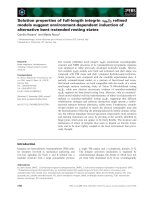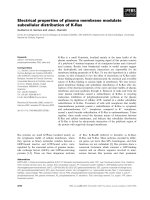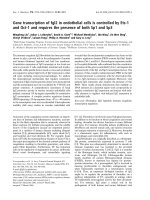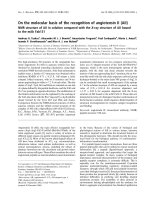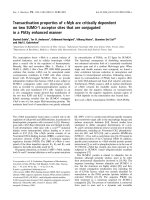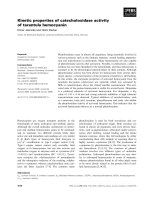báo cáo khoa học:" Psychometric properties of the OLQ-13 scale to measure Sense of Coherence in a communitydwelling older population" potx
Bạn đang xem bản rút gọn của tài liệu. Xem và tải ngay bản đầy đủ của tài liệu tại đây (924.97 KB, 9 trang )
RESEARCH Open Access
Psychometric properties of the OLQ-13 scale to
measure Sense of Coherence in a community-
dwelling older population
Jenneken Naaldenberg
1*
, Hilde Tobi
2
, Franciska van den Esker
1
and Lenneke Vaandrager
1
Abstract
Background: With the ongoing demographic shift, the quality of life and health promotion among older
individuals are becoming increasingly important. Recent research suggests that Sense of Coherence positively
affects quality of life. Hence, a valid and reliable measurement of Sense of Coherence is pivotal. The 13-item
Orientation to Life Questionnaire (OLQ-13) can be used to measure Sense of Coherence. The purpose of the
present study is to assess the psychometric properties, validity, and reliability, of the OLQ-13 in community-
dwelling individuals, aged 65 and older.
Methods: The OLQ-13 scale was administered as part of a healt hy aging project for non-institutionalized people
aged 65 years and older. Internal consistency and reliability were assessed by means of inter-item and test-halves
correlations and Cronbach’s alpha. Construct validity was explored using cluster analysis and exploratory factor
analysis (n = 703) and tested using confirmatory factor analysis on a separate subset of in dividuals (n = 658). Item
face validity was investigated by means of 12 semi-structured interviews.
Results: The reliability and the validity of the OLQ-13 in this population of non-institutionalized individuals aged 65
years and older was ambiguous, at least partly due to the poor performance of two items (b and d), which was
confirmed by results from the qualitative part of this study. The psychometric properties of the proposed OLQ-11,
obtained by deleting the two items, were better. In particular, the interpretation of exploratory factor solution
improved. Whereas the underlying theoretical constructs could not be linked to the exploratory analyses of OLQ-
13, this was to some extent possible in OLQ-11. The superior validity of OLQ-11 over OLQ-13 was supported by the
better model fit in the confirmatory factor analysis.
Conclusions: The present mixed-method study suggests the proposed OLQ-11 as a more suitable instrument for
measuring Sense of Coherence than the OLQ-13 in a population of ageing individuals. This study confirms that the
validity and reliability of OLQ-13 may differ substantially in different populations.
Background
Salutogenesis offers a theoretical approach to heal th pro-
motion in which Sense of Coherence (SO C), the ability
to use available resources in a health promoting way,
takes a central place [1-3]. Within the salutogenic theory,
Sense of Coherence is desc ribed as a global orientation
that expresses the extent to which individuals have a feel-
ing of confidence that their environment is structured,
predictable and explicable; resources are available to
meet challenges; and these challenges are worth engaging
in [1]. Following this description, Sense of Coherence is
further conceptualized by three different dimensions: a)
comprehensibility, the cognitive component, b) manage-
ability, the instrumental component and c) meaningful-
ness, the emotional component [2,4,5]. Together, these
comp onents reflect the interactions of an individual with
resources in the environment. Individual s with a high
SOC are expected to be confident that they have control
over their situation and know how to act in a health pro-
moting way [4,6].
Sense of Coherence in individuals is usually measured
by the 29-item orientation to life questionnaire (OLQ)
* Correspondence:
1
Health and Society group, Wageningen University, Hollandseweg 1
Wageningen, The Netherlands
Full list of author information is available at the end of the article
Naaldenberg et al. Health and Quality of Life Outcomes 2011, 9:37
/>© 2011 Naaldenberg et al; licensee BioMed Central Ltd. This is an Open Access article distributed under the terms of the Creat ive
Commons Attribution License ( which permits unrestricted use, distribution, and
reproduction in any medium, provided the original work is pr operly cited.
or the shorter 13-item version of this questionnaire
[2,7]. Items in these questionnaires are designed to mea-
sure one of the SOC dimensions: meaningfulness (ME, 8
resp. 4 items), manageability (MA, 10 resp. 4 items) and
comprehensibility (CO, 11 resp. 5 items). Items are
scored on 7-point scales. Missing values are not allowed
in computing a sum score for an individual. Scores for
each sub dimension may be computed as well [2].
The OLQ has been translated and used in many coun-
tries and in different populations [7]. A general problem
concerning the OLQs is that the three conceptual
dimensions never appear clearly from the data in factor
analyses [2,4]. Several studies ha ve investigated the fac-
tor structure of the OLQs by both explorato ry and con-
firmatory techniques. Some of these studies suggested a
one factor structure [8-10], whereas others proposed
several factors, not necessarily in line with the original
dimensions [11,12]. Studies using confirmatory techni-
ques presented a better fit for mo dels with the three
dimensions related to SOC (second order three factor
models) than models relating the individual items to
SOC (one factor models) [10,13-15]. Overall, the factor-
ial structure of OLQ seems to be multi-dimensional
rather than one dimensional [7].
Recent research suggests that interventions aimed at
aging populations can benefit by taking into account
concepts like Sense of Coherence of individuals in the
target population [16-21]. Hence, a valid and reliable
measurement of Sense of Coherence is pivotal . The aim
of this study is to assess the psychometric properties,
validity and reliability of the OLQ-13 in community-
dwelling older population, aged 65 and over.
Methods
Data and study population
Thisstudyuseddatafromalargehealthyageingproject
[22] for which a random study sample of 4,050 non-insti-
tutionalized people aged 65 years and over was selected
from the municipal registration system of three participat-
ing municipalities in the eastern part of the Netherlands.
Because the response rate in the oldest age group 75 year
and over was expected to be smaller than the age group
65 to 74 years, this group was oversample d to co nstitute
half of the study population. Data were collected in August
2008 by means of a 60-item, self-administered question-
naire that included the existing Dutch OLQ-13 [23]. Since
this study was not invasive to the participant’s integrity, it
did not require a formal ethics review following the cri-
teria of the Medical Research Involving Human Subjects
Act. The use of personal data in this study was in compli-
ance with the Dutch Personal Data Protection Act and the
Municipal Database Act. It has been registered with the
Dutch Data Protecti on Authority under number1440826
[22].The response rate to this survey was 67%. To limit
multiple use of the same data for future analyses, a ran-
dom subset of 1,361 respondents was used in this study.
Five items in the OLQ-13 questionnaire were reverse-
codedinordertoscoreintherightdirection(high
score meaning high SOC, see table 1). Missing data
were handled as appropriate to each specific analysis
being pairwise deletion for correlations, list wise exclu-
sion for exploratory factor analyses and full estimation
maximum likelihood estimation in the confirmatory fac-
tor analyses. Where the focus was on the items within
the scale (cluster analyses, Cronbach’s alpha) all respon-
dents on these items were included.
Reliability and internal consistency
Inter-item correlations, split-half correlations and Cron-
bach’s alpha were used to investigate reliability and inter-
nal c onsistency. Items were correlated using a standard
Pearson’s correlation. The spli t-half reliability procedure
was repeated three times, e ach using different ways to
split OLQ-13 into two halves , after which the Spearman-
Brown split-half reliability coefficient was comput ed. The
first approach followed a standard procedure fo r split-
half analysis in which the OLQ-13 was split into halves
based on order of items (resulting in a test half consisting
of items a to g and a test half with items h to m). Next, to
create more equivalent halves, different dimensions of
Sense of Coherence were taken into account and divided
equally over the test halves. In the third approach, the
OLQ-13 was divide d into test halves based on item score
means and standard deviation. Table 1 provides an over-
view of items, que stions, and test halves. Cronbach’ s
alpha was computed for the OLQ-13 as a whole as well
as for each Sense of Coherence sub dimension.
Validity
In order to i nvestigate construct validity, the data were
randomly divided over a construction set of size n =
703 and a confirmation set of size n = 658. First, the
construction set was used to explore wheth er the theo-
retical dimensions meaningfulness, manageability and
comprehensibility would appear within the data.
Structures within the data were explored by means of
exploratory factor analysis using principal axis factoring
with oblique rotation. Screeplots, Eigenvalues > 1, and
Horn’s parallel procedure [24] were used to assess the
number of factors to extract. Also, a hierarchical cluster
analysis applying Ward’ s method was used to identify
homogenous groups of variables. Ward’s method mini-
mizes distances within groups while maximizing differ-
ences between group and thus provides the best chance
of identifying relevant clusters of items [25].
Secondly, face validity of the items was investigated
based on 12 (six male, six female) face-to-face semi-
structured interviews. Interviewees were living within the
Naaldenberg et al. Health and Quality of Life Outcomes 2011, 9:37
/>Page 2 of 9
same geographical district as used for the survey. Six
interviewees were age d 65 to 74 years, the others were 75
or older. Interviewees were asked to complete the OLQ-
13 (Dutch translation as used in the survey) and were
probed to elaborate on the meaning and relevance of
items and their in terpretation of the ques tions and
answering scales. Transcripts were made verbatim. Data
were analyzed for content in the response per item and
the cognitive process of scoring. Firstly, a domain analysis
was performed for the response per item and the cogni-
tive process of scoring in order to obtain e mic accounts
of the interviewees [26]. This was followed by a content
Table 1 Overview items characteristics and test halves composition (N = 1361)
Item (dim) Question Mean Sd th 1 a/b th 2 a/b th 3 a/b
A (ME) Do you have the feeling that you don’t really care about what goes on around you?
(recode)
5.38 a b b
1 2 3 4 5 6 7 1.49
Seldom or never Very often
B (CO) Have you ever been surprised by the behavior of people you thought you knew well?
(recode)
4.69 a b b
1.77
12 345 6 7
Never happened Always happened
C (MA) Have people you counted on, disappointed you? (recode) 4.80 a a a
1 2 3 4 5 6 7 1.78
Never happened Always happened
D (ME) Until now your life has had: 4.64 a a a
1 2 3 4 5 6 7 1.72
No clear goals or purposes at all Very clear goals or purposes
E (MA) Do you have the feeling that you are being treated unfairly? 5.41 a a a
1 2 3 4 5 6 7 1.60
Very often Seldom or never
F(CO) Do you have the feeling that you are in an unfamiliar situation and don’t know what to do? 5.69 a a b
1 2 3 4 5 6 7 1.44
Very often Seldom or never
G (ME) The things you do every day are (recode): 5.25 a b a
1 2 3 4 5 6 7 1.20
A source of deep pleasure and satisfaction a source of pain and boredom
H (CO) How often are you’re feelings and ideas mixed-up? 5.82 b a a
1 1.40 2 3 4 5 6 7
Very often Seldom or never
I (CO) Do you sometimes have feelings you would rather not have? 5.31 b b b
1 2 3 4 5 6 7 1.55
Very often Seldom or never
J (MA) Many people - even those with a strong character - sometimes feel unlucky in certain
situations. How often have you felt this way in the past? (recode)
5.21 1.60 b b b
12 345 6 7
Seldom or never Very often
K (CO) When something happened, do you in your opinion usually: 4.97 b a b
1 1.36 2 3 4 5 6 7
Over- or underestimate it’s importance saw things in the right proportion.
L (ME) How often do you have the feeling that there’s little meaning in the things you do in your
daily life?
5.49 1.38 b a a
12 345 6 7
Very often Seldom or never
M (MA) How often do you have feelings of which you’re not sure if you can control them? 5.56 1.41 b b a
12 345 6 7
Very often Seldom or never
Naaldenberg et al. Health and Quality of Life Outcomes 2011, 9:37
/>Page 3 of 9
analysis, in order to describe aspects of Sense of Coher-
ence as expressed by the interviewees [27]. The discus-
sion of results will focus on those items that are of
interest to the overall aim of this paper.
Fina lly, resul ts from both the explorative analyses and
the qualitative analysis were used in the confirmative
stage to test different structures using the confirmation
dataset. Confirmatory factor analyses with full informa-
tion maximum likelihood estimation (FIML) was used
to estimate the models. FIML estimation yields consis-
tent and efficient estimates when data are missing at
random [28]. Fit indices Chi
2
,CFIandRMSEAwere
compared for each of the fitted models.
Analyses were performed using PASW 17 software,
and AMOS 17 software for the confirmatory factor ana-
lyses (). The analysis of the qualita-
tive data was supported by the u se of Atlas ti. software
( />Results
Descriptives
Of the 1,361 included respondents, 43% were men and
57% women, with ages ranging from 65 to 101 (Mean =
75, SD = 6.8) and 49.4% in the age group 65-74. Table 2
summarizes the descriptivesfortheOLQ-13question-
naire in the present sample.
Internal consistency and reliability
Inter-item correlations
Inter-item correlations are provided in table 3. All cor-
relations were positive except for the negative corre la-
tions of item d with item b, and item d with item c
after recoding of those items. The correlation between
item c and b is remarkably high at r = .718.
Split-half reliability
The correlation coefficient for halves 1a/b (see table 1)
was r = .60 with a reliability coefficient of .75. The equal
division of theoretical dimensions over test halves (2a/b,
table 1) gave a correlation coefficient of r = .68 and a
reliability coefficient of .80. When halves were composed
data driven (3a/b, table 1), an r = .76 and a reliability
coefficient of .86 were obtained.
Cronbach’s alpha
The Cronbach’ s alpha for the OLQ-13 was .80. The
dimensions scored lower, with the alpha for
meaningfulness at .53; the alpha for manageability at
.58; and the alpha for comprehensibi lity at .64. Delet-
ing items resulted in marginal improvements, deleting
item b from the comprehensibility dimension increased
the alpha to .71.
Validity
The high correlation of item b with item c, the
improved Cronbach’s alpha on deletion of item b and
the negative correlations of item d with both items, gave
cause to delete both item b and item d, thus obtaining
OLQ-11. Validi ty analyses were therefore performed on
both the OLQ-13 and the OLQ-11.
Exploratory factor analysis
In both the OLQ-13 and the OLQ-11, there was no
unambiguous indication of the number of factors to
extract. Examination of the screeplot indicated a one
factor solution, whereas the Eigenvalues > 1 criterion
and Horn’s parallel p rocedure suggested a three factor
solution. The pattern matrix for the three factor solu-
tion in both the OLQ-13 and the OLQ-11 is presented
in table 4. The factor solution for the OLQ-13 was hard
to interpret. The solution for the OLQ-11 seemed less
ambiguous with regard to the theoretical dimensions of
Sense of Coherence. Factor correlations between the
three factors ranged from r = 1.8 to r = .52 in the OLQ-
13, and r = .44 to r = .45 in the OLQ-11.
Cluster analysis
Cluster analysis of the OLQ-13 resulted in a hard-to-
interpret and messy structure in which the theoretical
Sense of Coherence dimensions were not identifiable.
Again, the OLQ-11 showed a more coherent picture
with more resemblance to the theoretical dimensions.
However, the strongest cluster was found between two
items designed to represent manageability and compre-
hensibility. This is illustrated by the dendrogram in
figure 1.
Item face validity
Overall, interviewees encountered difficulties in answer-
ing and interpreting at least some of the questions in
the OLQ-13. More specifically, item b) “ Have you ever
been surprised by the behavior of people you thought
you knew well?” anditemc)“Have people you counted
on, disappointed you?” were frequently interpreted as
addressing the same issue. Interviewees were missing
Table 2 Descriptives for the Orientation to life questionnaire, OLQ-13 (n = 1361)
Orientation to life questionnaire
(13 items)
Meaningfulness
(4 items)
Manageability
(4 items)
Comprehensibility
(5 items)
Mean Sum
score
68 20 20 26
Sd 10 3.8 4.3 4.8
Missing 248 177 151 200
Naaldenberg et al. Health and Quality of Life Outcomes 2011, 9:37
/>Page 4 of 9
the nuance, and the phrasing “surprised” in the question
for item b was perceiv ed in a negative connotation, as a
disappointment. When probed, interviewees perceived
item c as relating to the manageability dimension. Item
b, however, was not perceived by the interviewees as
relating to any of the theoretical dimensions.
Item d) “Until now your life has had: No clear goals or
purposes at all Very clear goals or purposes” was per-
ceived as referring to the future. Interviewees related
these future goals to the context of occupation and
work, and therefore did not think it was applicable to
aging individuals who had already retired. When probed,
interviewees related this item to the meaningfulness
dimension.
With regard to item k) “When something happened,
do you in your opinion usually: Over- or underestimated
it’ s importance saw things in the right proportion”
interviewees struggled to answer the question. This item
was regarded as difficult, unclear and too broad. Inter-
viewees had no clear view about the dimension to which
this item relates.
Item m) “How often do you have feelings of which
you’re not sure if you can control them?” was perceived
as relating to negative emotions. Interviewees men-
tioned: anger, loneliness, tensions and reluctance and
the degree of control over these emotions. This item
was perceived to relate to the comprehensibility
dimension.
Confirmatory factor analysis
Confirmatory factor analysis was performed on both
OLQ-13 and OLQ-11 using the confirmation set. A one
factor model connecting the i tems directly to one factor
being Sense of Cohe rence was tested, followed by a first
Table 4 Pattern matrix principal axis factoring, oblique rotation (n = 703)
Factor solution OLQ-13 Factor solution OLQ-11
item dim 1 2 3 1 2 3
A Me - - .408 - - .405
B Co - .753 -
C Ma - .880 - 150 .669 -
D Me .128 223 .348
E Ma .285 .198 .102 .160 .368 -
F Co .512 - .163 .455 .165 .120
G Me .142 - .409 .117 .126 .374
H Co .818 - - .850 - -
I Co .787 - - .714 .101 -
J Ma .363 .299 - .139 .576
K Co .259 - .327 .283 - .266
L Me .109 - .699 .167 - .728
M Ma .627 - .182 .624 - .206
Explained variance 32% one factor/42% three factor 35% one factor/40% three factor
Values below .100 suppressed
Table 3 Inter-item correlations orientation to life questionnaire, OLQ-13 (n = 1361)
AB C DEF GHI J KL M
A 1- -
B .189 1 - - -
C .184 .718 1 - -
D .089 112 079 1 -
E .132 .176 .223 .154 1
F .138 .109 .191 .224 .328 1
G .219 .185 .209 .181 .157 .277 1
H .151 .087 .121 .171 .278 .471 .277 1 - - - - -
I .084 .152 .209 .148 .257 .403 .326 .572 1 - - - -
J .122 .263 .327 .083 .254 .248 .310 .271 .323 1 - - -
K .132 .081 .143 .212 .200 .304 .112 .311 .262 .101 1 - -
L .242 .129 .181 .252 .238 .352 .392 .378 .390 .227 .263 1 -
M .201 .169 .180 .176 .266 .442 .289 .527 .519 .288 .322 .436 1
Naaldenberg et al. Health and Quality of Life Outcomes 2011, 9:37
/>Page 5 of 9
order model in which the three dimensions were
included. The fit indices for the tested mode ls: Chi
2
,
RMSEA and GFI, as well as the factor Sense of Coher-
ence and dime nsion variances, are provided in t able 5.
The Chi
2
values in all models were highly significant
due to over sensitivity to the large sample size. The
unique factor variances in all models are up to ten
times larger t han the factor Sense of Coherence or the
dimension’ s variances, respectively. The OLQ-13 first
order model failed to run properly because the covar-
iance matrix was not positive definite, and a Chi
2
could
not be computed.
For both the OLQ-13 and the OLQ-11, the second
order model construction resulted in a model that was
mathematically equivalent to the one factor models and
therefore is not included in the table.
Compared to the one factor Sense of Coherence
model, the first order model yielded better fit indices.
Overall, the OLQ-11 models performed better than the
OLQ-13 models. The path diagram and parameters for
the best fitting first order OLQ-11 model is provided in
figure 2.
Discussion
The reliability and the validity of the OLQ-13 in this
population of non-institutionalized individuals aged 65
years and older was ambiguous, at least partly due to
the poor performance of item b and item d. This pro-
blem has been reported before and seems to be
resolved, at least partly, by excluding t he items b and d
from the analysis [29]. The psychometric properties of
the OLQ-11 (obtained by deleting the two items) were
indeed better, in particular the exploratory factor solu-
tion. Where the underlying theoretical constructs could
not be linked to the exploratory analyses of OLQ-13,
this was to some extent possible in OLQ-11 with
Table 5 CFA fit indices and variance (n = 658)
Df Chi^ CFI RMSEA Var SOC Range error var.
OLQ-13 one factor model 65 618 .731 .114 .22 1.01 to 3.00
OLQ-11 one factor model 44 142 .930 .058 .21 .99 to 2.96
Var. me Var. ma Var. co
OLQ-13 first order model na na .723 .115 .28 .48 .75 .87 to 2.92
OLQ-11 first order model 41 123 .941 .055 .28 .41 .77 .88 to 2.95
Figure 1 Dendrogram cluster analysis without item b & d (N = 703).
Naaldenberg et al. Health and Quality of Life Outcomes 2011, 9:37
/>Page 6 of 9
problems remaining due to items k and item m. The
superior validity of OLQ-11 over OLQ-13 was sup-
ported by the bette r model fit in the confirmatory factor
analysis. It is important, however, to acknowledge the
relatively large unique factor variances in the model,
suggesting substantial “noise”.
The reported high correlation between item b and
item c has also been found in other studies [1 0,29,30],
and could be explained in the present study by intervie-
wees perceiving these questions as similar.
The present study confirmed the multi-dimensional
nature of SOC in the aging population, previously
shown for other populations [8-10,31]. Whether to view
Sense of Coherence as a one factor model or a three
factor model has often b een debated in the literature
[2,8-10,15,32,33]. This study therefore applied several
criteria to extracting factors in the exploratory analyses,
eventually suggesting a three factor model. Moreover,
both the three factor and one factor solution were
further tested in confirmatory analyses.
Figure 2 Path diagram 11 item first order CFA model (N = 658).
Naaldenberg et al. Health and Quality of Life Outcomes 2011, 9:37
/>Page 7 of 9
The present study focused on the reliability and the con-
struct and face validity of the OLQ-13 among community-
dwelling older individuals and suggested the OLQ-11. It
did not look into the divergent validity by investigating
whether SOC appears as a salutogenic construct distinct
from quality of life and (absence of) depression. That this
may be an issue was shown in a study on girls age d 14 to
18 years [34]. Blom et al [34] concluded that symptoms of
anxiety and depression were better captured in the OLQ-
29 than in the specialized scales they considered. It would
be interesting to investigate whether similar issues arise in
clinical and non-clinical groups of older individuals.
The OLQ-13 has been translated and used in many
countries and in different population s. Generally spea k-
ing, translation of scales and questionnaires requires
explicit attention since translation may influence validity
[35]. No published information is available on the trans-
lation difficulties and resulting (lack of) equivalence of
the OLQ-13 in Dutch.
Although a response rate of 67% is generally considered
sufficient, this does not imply full representativeness of the
population under study per se. In this study the percen-
tages for the men and women match th ose of the general
population (42% men and 57% women) for the participat-
ing municipalities [36]. The over-sampling of the age
group 75 and over prevented the bias of under representa-
tion of this group. However, this study aimed to assess the
OLQ-13 scale and the items within it rather than to draw
conclusions on the populatio n under study. This makes
issues of representativeness of less importance.
This study is unique in its mixed-method approach to
the study of OLQ: it combines of qualitative and quanti-
tative approaches/data. The added value of this combi-
nation lies in the quantitative part providing enough
data to work with a separate construction and validation
set, and the qualitative part of this study providing t he
detailed in-depth information necessary to understand
what made particular items problematic for members of
this population. The qualitative part gave the context
that allowed for a better understanding of problems that
presented themselves in individu al items. Since the data
for the qualitative part were collected before the quanti-
tative analyses, they can be regarded as independent:
neither the quantitative nor the qualitative data collec-
tion was influenced by previous results.
Interpretation of the Cronbach’s alpha scores is pro-
blematic since these alpha scores are influenced by the
number of items tested, which were higher for the scale
as a whole and the comprehensibility dimension. This
problem is illustrated by Olsson [37] in a study compar-
ing the OLQ-29 and OLQ13, showing higher values for
the OLQ-29. This study therefore also used split-half
and inter-item correlations to assess reliability.
Conclusion
The present mixed-method study suggests the proposed
OLQ-11 as more suitable than the OLQ-13 in this
population of aging individuals. In addition, this study
illustrates that the validity and reliability of OLQ-13
may differ substantially for d ifferent populat ions since it
was shown that aging individuals did not alwa ys inter-
pret the questions as intended. Further qualitative inves-
tigation of interpretations b y ot her populatio ns is
therefore advisable.
Acknowledgements
This study is part of the Healthy Ageing project of academic collaborative
center AGORA, funded by: The Netherlands Organization for Health Research
and Development ZonMW (project number 50-50400-98-008). The authors
wish to thank Rianne de Vlaming who conducted the survey and made this
data available and the community health services GGD Gelre-IJssel for
facilitating the data collection.
Author details
1
Health and Society group, Wageningen University, Hollandseweg 1
Wageningen, The Netherlands.
2
Research Methodologies Group,
Wageningen University, Hollandseweg 1 Wageningen. The Netherlands.
Authors’ contributions
JN and HT carried out the statistical analyses and drafted the manuscript. FE
performed and analyzed the qualitative part of this study. LV helped to draft
the manuscript and contributed to the analyses of the qualitative data. All
authors read and approved the final manuscript.
Competing interests
The authors declare that they have no competing interests.
Received: 29 December 2010 Accepted: 23 May 2011
Published: 23 May 2011
References
1. Antonovsky A: Unraveling the mystery of health San Francisco: Jossey-Bass;
1987.
2. Antonovsky A: The structure and properties of the sense of coherence
scale. Soc Sci Med 1993, 36:725-733.
3. Antonovsky A: The salutogenic model as a theory to guide health
promotion. Health Promot Int 1996, 11:11-18.
4. Eriksson M, Lindström B: Validity of Antonovsky’s sense of coherence
scale: a systematic review. J Epidemiol Community Health 2005,
59:460-466.
5. Lindström B, Eriksson M: Salutogenesis. J Epidemiol Community Health 2005,
59:440-442.
6. Eriksson M, Lindstrom B: A salutogenic interpretation of the Ottawa
Charter. Health Promot Int 2008, 23:190-199.
7. Eriksson M: Unravelling the mystery of salutogenesis, the evidence base
of the salutogenic research as measured by Antonovski’s Sense of
Coherence scale. Helsinki: Folkhälsan Research Centre 2007.
8. Gana K: Is sense of coherence a mediator between adversity and
psychological well-being in adults? Stress and Health 2001, 17:77-83.
9. Frenz AW, Carey MP, Jorgensen RS: Psychometric evaluation of
Antonovsky’s Sense of Coherence Scale. Psychol Assess 1993, 5:145-153.
10. Feldt T, Leskinen E, Kinnunen U, Mauno S: Longitudinal factor analysis
models in the assessment of the stability of sense of coherence. Pers
and Individ Dif 2000, 28:239-257.
11. Larsson G, Kallenberg K: Dimensional analysis of sense of coherence
using structural equation modelling. Eur J of Pers 1999, 13:51-61.
12. Germano D, Misajon R, Cummins RA: Quality of Life and Sense of
Coherence in People with Arthritis. J Clin Psychol Med Settings 2001,
8:253-261.
Naaldenberg et al. Health and Quality of Life Outcomes 2011, 9:37
/>Page 8 of 9
13. Feldt T, Lintula H, Suominen S, Koskenvuo M, Vahtera J, Kivimäki M:
Structural validity and temporal stability of the 13-item sense of
coherence scale: Prospective evidence from the population-based
HeSSup study. Qual Life Res 2007, 16:483-493.
14. Feldt T, Rasku A: The structure of Antonovsky’s Orientation to Life
Questionnaire. Pers Individ Dif 1998, 25:505-516.
15. Sandell R, Blomberg J, Lazar A: The factor structure of Antonovsky’s sense
of coherence scale in Swedish clinical and nonclinical samples. Pers
Indvid Dif 1998, 24:701-711.
16. Naaldenberg J, Vaandrager L, Koelen M, Leeuwis C: Ageing
populations’everyday life perspectives on healthy ageing, new insights
for policy and strategies at the local level. Appl gerontology 2011.
17. Lezwijn J, Vaandrager L, Naaldenberg J, Wagemakers A, Koelen M, Van
Woerkum C: Healthy ageing in a salutogenic way: building the HP 2.0
framework. Health Soc Care Com 2010.
18. Wiesmann U, Hannich HJ: A salutogenic view on subjective well-being in
active elderly persons. Aging Ment Health 2008, 12:56-65.
19. Billings J, Hashem F: literature review Salutogenesis and the promotion
of positive mental health in older people. Mental health and well-being in
older people-making it happen; Madrid European Communities; 2009.
20. Forbes DA: Enhancing mastery and sense of coherence: Important
determinants of health in older adults. Geriatr Nurs 2001, 22:29-32.
21. Drageset J, Nygaard H, Eide G, Bondevik M, Nortvedt M, Natvig G: Sense of
coherence as a resource in relation to health-related quality of life
among mentally intact nursing home residents - a questionnaire study.
Health Qual Life Outcomes 2008, 6:85.
22. de Vlaming R, Haveman-Nies A, van’t Veer P, de Groot L: Evaluation design
for a complex intervention program targeting loneliness in non-
institutionalized elderly Dutch people. BMC Public Health 2010, 10:552.
23. Jellesma F, Meerum Terwogt M, Rieffe C: Nederlandstalige Sense of
Coherence vragenlijst voor kinderen. [the Dutch sense of coherence
questionaire for children]. Gedrag & Gezondheid [Behavior & Health] 2006,
34:18-26.
24. Allen SJ, Hubbard R: Regression equations for the latent roots of random
data correlation matrices with unities on the diagonal. Multivariate Behav
Res 1986, 21:393-398.
25. Garson D: Statnotes: Topics in Multivariate Analysis, Cluster analysis.
[ Acces date 10-21-
2010.
26. Coffey A, Atkinson P: Making sense of qualitative data: complementary
research strategies Thousand Oaks, CA: Sage Publications; 1996.
27. Silverman D:
Interpreting Qualitative Data Methods for Analyzing Talk Text
and Interaction. Third edition. London: Sage Publications; 2006.
28. Schumaker R, Lomax R: A beginner’s guide to structural equation modeling
New York: Taylor & Francis Group LLC; 2004.
29. Hittner JB: Factorial invariance of the 13-item sense of coherence scale
across gender. J Health Psychol 2007, 12:273-280.
30. Bernabé E, Tsakos G, Watt R, Suominen-Taipale A, Uutela A, Vahtera J,
Kivimäki M: Structure of the sense of coherence scale in a nationally
representative sample: the Finnish Health 2000 survey. Qual Life Res
2009, 18:629-636.
31. Eriksson M, Lindstrom B, Lilja J: A sense of coherence and health,
Salutogenesis in a societal context: Aland, a special case? J Epidemiol
Community Health 2007, 61:684-688.
32. Flannery RB, Perry CJ, Penk WE, Flannery GJ: Validating Antonovsky’s sense
of Coherence scale. J Clin Psychol 1994, 50:575-577.
33. Muller Y, Rothman S: Sense of coherence and employees’ perceptions of
helping and restraining factors in an organisation. SA J Industrial Psychol
2009, 35:89-98.
34. Blom EH, Serlachius E, Larsson JO, Theorell T, Ingvar M: Low Sense of
Coherence (SOC) is a mirror of general anxiety and persistent depressive
symptoms in adolescent girls - a cross-sectional study of a clinical and a
non-clinical cohort. Health Qual Life Outcomes 2010, 8:58.
35. Harkness JA, Braun M, Edwards B, Johnson T, Lijberg L, Mohler P, Pennell B,
Smith T: Survey methods in multinational, multiregional and multicultural
contexts New Jersey: John Wiley & Sons Inc; 2010.
36. CBS statline. [ />03759ned&D1=1-2&D2=125-128,l&D3=296-297,901&D4=20&HDR=T&STB=G2,
G1,G3&VW=T] access date 18 April 2011].
37. Olsson M, Gassne J, Hansson K: Do different scales measure the same
construct? Three ense of Coherence scales. J Epidemiol Community Health
2009, 63:166-167.
doi:10.1186/1477-7525-9-37
Cite this article as: Naaldenberg et al.: Psychometric properties of the
OLQ-13 scale to measure Sense of Coherence in a community-dwelling
older population. Health and Quality of Life Outcomes 2011 9:37.
Submit your next manuscript to BioMed Central
and take full advantage of:
• Convenient online submission
• Thorough peer review
• No space constraints or color figure charges
• Immediate publication on acceptance
• Inclusion in PubMed, CAS, Scopus and Google Scholar
• Research which is freely available for redistribution
Submit your manuscript at
www.biomedcentral.com/submit
Naaldenberg et al. Health and Quality of Life Outcomes 2011, 9:37
/>Page 9 of 9
